[Lauren allows the mood of Lynnea Holland-Weiss’ work to sweep over her, imagining the stories inside the artists’ paintings. — the Artblog editors]
There are many formal ways to introduce artwork in a critique, but I’m going to err on the side of casual and say up-front that I am absolutely mesmerized by Lynnea Holland-Weiss’ paintings. Holland-Weiss argues in the show’s press release that she is “setting a mood [rather] than creating a narrative.” But, I beg to differ: Doesn’t a mood create narrative? It does indeed–a joyous undertone breathing through a painting makes a viewer question the cause of happiness. Anger raging through brushstrokes causes the viewer to seek a story behind the anger. Every painting tells a story; whether it is a literal narrative or, in Holland-Weiss’ case, a mood, the human mind, which is always looking for a story, will find one.
Saturated, enigmatic scenes
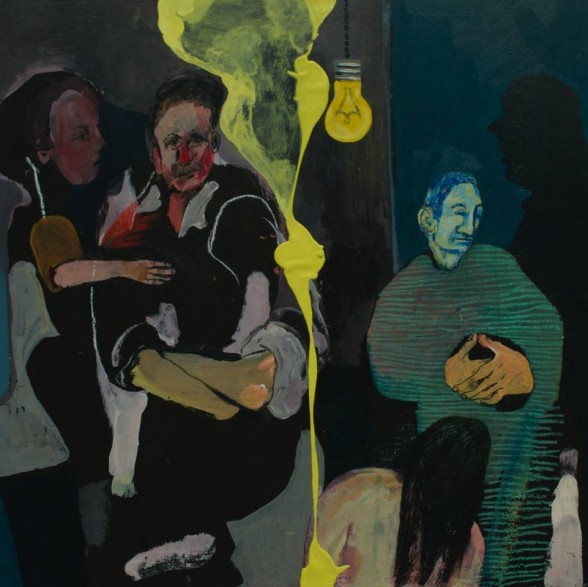
“All of a Sudden, The Weight” is one of the smaller paintings in the show. Measuring 16” x 16”, it’s a panel built up with layers of paint and (what appears to be) pastel. Four androgynous figures sit in a dark room, reminiscent of Picasso’s groups of people wallowing in bars or Nicole Eisenman’s Old Master updates of Picasso’s bar scenes, shown recently at ICA.
Dark teal and cool, deep fleshy tones are offset by a brilliant yellow light bulb emitting a light billowing out like cigarette smoke. The blue-striped figure on the right has a drunken expression on his/her light blue face; two figures behind in the distance look on disapprovingly, one of the characters almost holding the other back. A crude, quick painting of the back of head and shoulders sits before the figure.
The feel of the piece is a dilapidated bar, long past its prime, filled with the last of its skeezy, drunken occupants. The blue figure and the kneeling figure seem to be engaged in some kind of sexual exchange–is this the lover of one of the angry figures caught in an act of betrayal? Is the figure drunk and looking for her phone on the floor while friends in the back angrily cry for her to hurry up because their Uber has arrived?
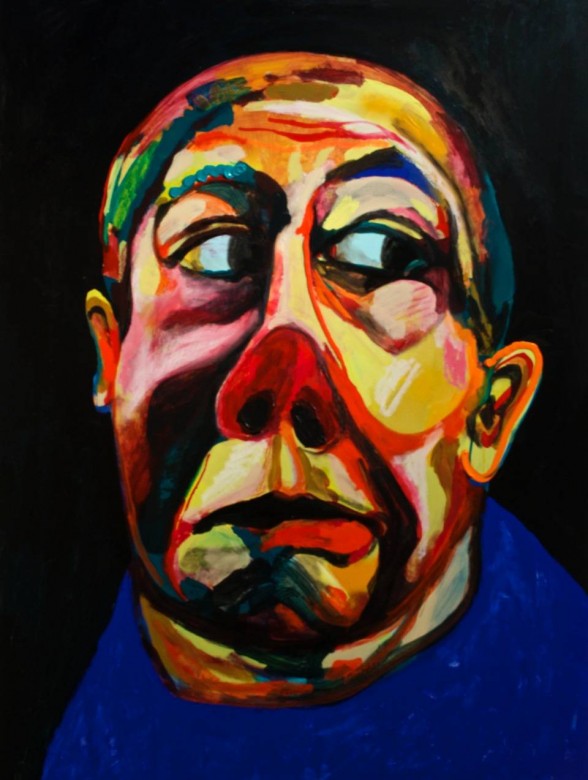
Farther over is “I Don’t Know,” a commanding portrait of a man looking like, well, I truly don’t know. He’s skeptical, and judging from the psychedelic palette, there’s a good chance he’s entering into some drug-induced rabbit hole. The vibrant painting combines different textures, from thin, built-up washes of color to thick, straight-from-the-tube lines demarcating the nose–a technique used frequently in this body of work.
The contrast is high; the darks are true blacks and the lightest colors are super-saturated yellows, cotton-candy pinks, and icy blues for the whites of the eyes, which provides the greatest contrast of all. A resemblance to Lucian Freud’s painting beams through this painting–the angular shapes in the face, the choice of expression–but it’s softened in areas, animated and alive, while Freud maintained a serious, stoic mood.
Mysterious faces and handmade books
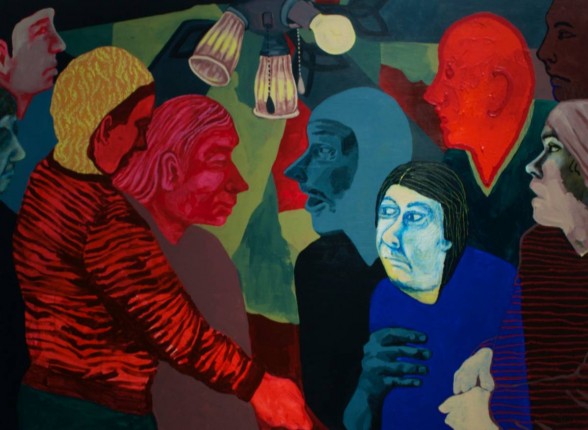
A small group of people caught in discussion is captured in “Circling Debate”. Due to choice in color, we can assume that those portrayed in blue are arguing with the red figures, while the other characters displayed in flesh tones are just neutral in the discussion. There’s a contrast between solid planes of color and fully painted and finished areas of the painting. The thickly painted line that made an appearance in “I Don’t Know” reappears as a primitive rendering on a red man’s face, while diagonally beneath him sits a blue woman with a bright blue, fully rendered face, her blue counterpart’s hand wrapping around her. Three lightbulbs gleam from the ceiling; a giant dartboard of sorts sits in the background. Are these the blue and red teams in a life-changing game of darts? Will the red and blue characters swap their lovers if the dart hits the bull’s-eye just so?
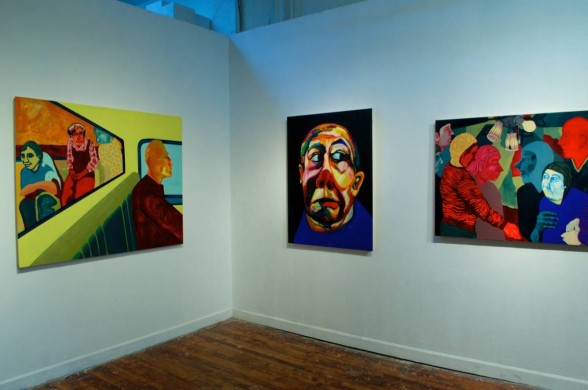
The amount of work in the show is impressive. Holland-Weiss shows 16 paintings and an enormous wall of 35 colored pencil portraits and 20 copies of her artist book–which are all handmade and really quite precious to hold. The clear love that went into each piece is not only overwhelming, but inspirational. In an era of largely digitally-based work, it’s refreshing to see an artist’s hand–and mood–breathing free and true.
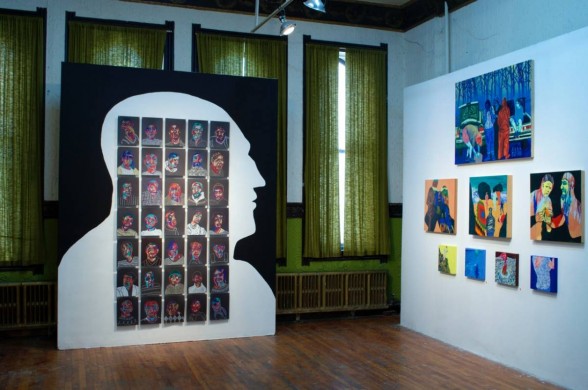
Unfold All Over is on display at Space 1026 from Feb. 6 – March 28, 2015. (Note: This show has been extended for a month past its original end date of Feb. 28, 2015.) For hours, appointments, and inquiries, contact the gallery at gallery@space1026.com.









